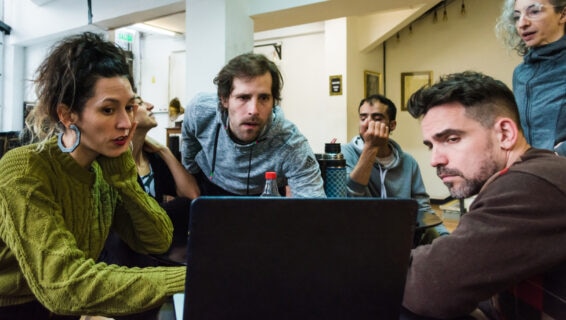
How to embed diversity and inclusion into your workforce wellbeing strategy
Table of Contents
- Important steps to consider
In May 2022, Totaljobs hosted a webinar focused on employee wellbeing, with Simon Blake OBE, Chief Executive Officer of Mental Health First Aid (MHFA) England, joining an expert panel.
Following this, Simon has kindly written the below piece to mark World Mental Health day on October 10th 2022, giving his expert view on how to ensure diversity, equity and inclusion sits at the heart of your organisation’s wellbeing strategy.
The last few years have been hard on everyone. Amidst a global pandemic, economic uncertainty, and changes to the ways we work, the need to support everyone’s mental health and wellbeing is greater than ever.
78%
of employees say they have experienced at least one symptom of burnout
A recent survey by Totaljobs concluded that 78% of employees say they have experienced at least one symptom of burnout this year and 1 in 4 businesses were concerned about the wellbeing support for their staff.
Many workplaces have responded to this need by increasing their mental health and wellbeing offering and Mental Health First Aiders (MHFAiders®) are a vital part of this. Last month we launched our new MHFA training and the appetite for it was staggering with over 3,000 people registering for our webinar, Exploring our new Mental Health First Aid course.
At MHFA England we are clear that we need a whole organisation approach to promoting the wellbeing of the whole workforce. Positive workplace cultures are ones where everyone feels a sense of belonging, feels valued, feels that their job has purpose and is manageable and that they have the tools and relationships to thrive. Organisations have different approaches to workforce wellbeing and inclusion but whatever the approach, it is absolutely vital that diversity and inclusion is embedded into your workforce wellbeing strategy, which in turn has to underpin your workforce strategy.
Equity and fairness are an important part of workforce wellbeing – what people get paid, the development opportunities and promotions that are offered, who gets recognised and heard for their (or other people’s) contributions and does everyone feel they express themselves freely – are central to a positive culture.
This may all sound obvious, but recent research shows us that 120,000 workers from racialised communities quit their jobs because of racism. Racism impact our mental health: it causes trauma and trauma can cause mental ill health.
On top of this, research from the Chartered Management Institute found that women are still woefully underrepresented across senior management positions in the UK, with only 41% of management positions being occupied by women despite making up 48% of the working population.
When you consider that despite women earning less than men on average, they are still more likely to manage daily household costs such as groceries and children’s items, you can see how the stress of the cost-of-living crisis could sit squarely on their shoulders. And what happens if you are a single parent, or perhaps live with a disability?
All of these factors speak to diversity and inclusion and will have an impact on our staff’s wellbeing and mental health.
Rightly, given the economic and human cost, there is a lot of focus on the negative impact of work on mental health. Deloitte estimates that poor mental health costs UK business £56 billion per year.
As we all continue to adapt to a new working world, we have a once in a lifetime opportunity to create a new playbook where we can truly ensure that inclusion, wellbeing and high performance go hand in hand.
Brave leaders will know there is no magic bullet, nor indeed is there a one size fits all approach, and they will be working in partnership with their teams to work out how to create inclusive cultures that support wellbeing. And they will recognise that doing so goes right to the heart of our business strategies for success.
Important steps to consider
- Be explicit about your commitment to equity, inclusion, and wellbeing. This means ensuring that you have diverse teams at all levels. Show and tell your staff that you are working hard to build a workforce and have a plan to eradicate inequalities including pay gaps.
- Build inclusion and wellbeing into your people and performance strategy – make sure it is embedded into job design, onboarding processes, 1:1s and health checks.
- Create a culture where everyone feels like they belong, is seen and valued. Our My Whole Self campaign has this at its heart. Whilst we celebrate My Whole Self Day every March, we ensure that all staff feel comfortable to bring their whole selves to work, every day.
- Create flexible ways of working that enable people to create balanced lives where work and home life exist together in harmony.
- Listen, engage and consult as part of the DNA of your organisation – employee resource groups can help to create direct pathways to senior management and help them understand what their staff need and want.
- Make sure line managers have the skills they need to be inclusive in their management and leadership and have quality conversations about wellbeing and mental health in their day to day work. Our Mental Health Skills for Managers and Mental Health Knowledge for Managers, empower managers to put wellbeing at the heart of their leadership approach
- As we navigate the new world of work, keep a laser sharp focus on the importance of social connection and recognise that our individual lived experiences will drive what feels good and helpful for each of us. For some, where the office felt unsafe, working from home has created a new, safe norm and that is important. However, we must stay connected and find successful ways to do that for everyone.
- Take purposeful action whether that be re -assessing or even ripping up your old wellbeing policy and starting again (our diagnostic service, Startwell, can help you with this) or ensuring that your work force has access to the most up to date and relevant mental health training in wellbeing and mental health.
- Taking actions across a range of fronts will take time and might be uncomfortable. Ruchika Tulshyan, in her excellent book, Inclusion on Purpose, offers readers the Bridge Framework. It is the perfect framework for navigating our way through these times of change and is one that I would encourage everyone to consider in their quest for true diversity and inclusion in the workplace.
- Be uncomfortable
- Reflect on what you don’t know
- Invite feedback
- Defensiveness doesn’t help
- Grow from your mistakes
- Expect that change takes time
Monday 10 October marks World Mental Health Day and this year’s theme is making mental health and wellbeing for all a global priority. We have produced a new resource for World Mental Health Day to help people prioritise mental health and wellbeing across their organisations. Our five tips for building a better workplace culture are available as a digital or printable poster.
Receive the latest recruitment resources and
advice to boost your hiring
By providing us with your details you agree to our privacy policy and for us to keep you updated with the latest news, events,
and special offers from Totaljobs.






